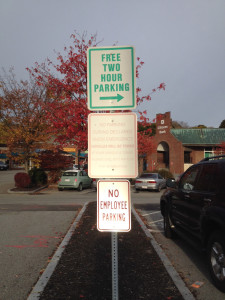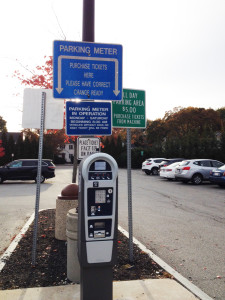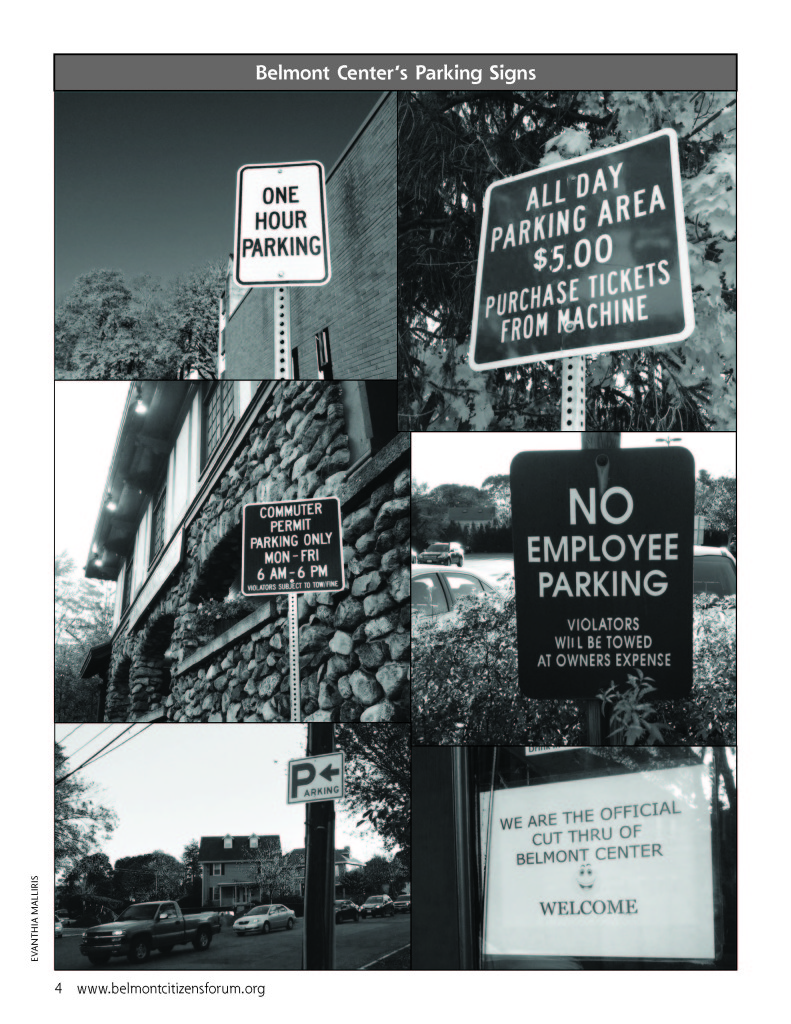
By Evanthia Malliris
It’s a common sight in Belmont Center, cars poking along Leonard Street, seeking that sweet reward, an open parking spot! A quick dash to the dry cleaners, pick up a coffee, and you’re on your way—and not even late for work.
But what if you can’t find that space? Maybe you’ll circle the block a few times, and if you’re not lucky, just head home. You’ll do the errand another time. But why not just park in the large municipal lot behind the Leonard Street businesses, or on a residential side street? After all, it’s just a few minutes to walk to the Center.
Not so fast.
A recent parking study of Belmont Center found many barriers to parking in Claflin lot and walking around to the shops, and center. Business owners and Belmont residents resoundingly agree.
Let’s go back to 2012, when the town commissioned a parking study from Nelson/Nygaard Consulting (available at www.belmont-ma.gov/sites/belmontma/files/file/file/final_parking_management_plan.pdf), as part of the greater Belmont Center redesign and construction, which is now very visibly underway. As the Belmont Citizens Forum Newsletter reported in the May 2014 issue, according to the study, “the problem in Belmont Center is that many of the most attractive, short-term parking spots for customers are monopolized by cars that park for two hours at a time or more. The most obvious and desirable parking closest to stores is free, while the Claflin lot is invisible and has a confusing, poorly signed mix of free and paid parking with no obvious access to Leonard Street.”
The study made six recommendations to improve parking in the center, which the Board of Selectmen voted to implement in March of 2012:
• Parking permits for employees and others be revised, with monthly rate discounts
• More convenient customer parking, charging for prime spaces on Leonard Street, with the first 15 minutes free to encourage short stops
• Introduce and charge for commuter parking
• Improve walking connections between the back parking lot and the Center, perhaps with a permanent easement between the two
• Create a signage program to help people get from the back parking lot to the Center, and to clearly differentiate short- and long-term parking
• Implement modern payment technology throughout, and specifically, replace the outdated pay station in the lot
According to Glenn Clancy, Belmont’s director of Community Development, the town has already implemented some of these recommendations and has plans to enact the remainder. About a year ago, the town installed new signs to help motorists find the Claflin Street parking lot. However, with the ongoing Center construction, some signs were temporarily removed. Once the project is complete, Clancy said, “we will revisit the signage to see if additions or modifications are necessary.”
There are now two upgraded parking pay stations in the back lot which take both coins and credit cards; metering starts at 8:30 am. In fiscal 2015, parking rates were increased to $1 per hour, and employee parking permits were increased to $90 per month from $60 per month. Employees can also pay for daily parking at $5 a day (formerly $3/day). In addition, as of February 2015, commuter parking permits were made available for $90 per month for the 10 spaces on Royal Road that were previously free, and for 10 spaces in the rear lot. According to the Belmont town parking office, there hasn’t been a lot of demand for commuter parking permits.
Parking pay stations are also planned for Leonard Street, and will be installed once the Belmont Center reconstruction project is completed. As recommended by Nelson/Nygaard, the goal is to encourage turnover of on-street parking spaces so that there is more inventory available to business customers. And as a result of the reconstruction work, about eight new parking spaces have been carved out, adding to the on-street inventory. Further, accommodations have been made to provide loading zones on both sides of Leonard Street to help relieve congestion during delivery times.
With Foodies Market scheduled to take over a large chunk of the old Macy’s building, there may be an uptick in parking demand by shoppers and employees. Clancy said, “As we learn more about the tenants at the old Macy’s site, we will see how that impacts our parking strategy in the center. We will stay flexible in our thinking, and continue conversations with the Belmont Center Business Association to receive feedback on parking issues.”
The town also plans to place bike racks near the green space in front of Belmont Savings Bank, and in several locations along Leonard Street. The racks are fairly mobile and can be relocated and added to as required by demand.
When asked about these six recommendations and how they think their businesses might be affected by them, center business owners agreed strongly with creating a permanent cut-through from the municipal lot to Leonard Street, as did Belmont citizens in an informal poll. There is general agreement that people just won’t walk around the block to get to the Center. Belmont resident Bonnie Friedman said, “It’s psychological. If they can’t see the store from their car, they think it’s far away. I think Lexington does a bit better with parking in the rear because they have clear cut-through walkways. Cutting through Champion’s or other stores might feel uncomfortable.”
However, Gerry Dickhaut, Champion Sport’s owner and head of the BCBA, is “proud to be the official cut-through of Belmont Center,” and has posted welcoming signs in his windows. Dickhaut agrees that people don’t seem to want to walk at all whether from a side street or from the parking lot.
Nelson/Nygaard identified Citizens Bank or Starbucks as possible cut-throughs. Citizens likely has good security, and might be willing to sell a 24-hour easement to the town. Behind Starbucks, there is a patio fence that could be removed. According to Clancy, the redesign of the Macy’s building is also expected to provide a cut-through, but it’s likely that it will be part of a larger commercial tenant space.
Some residents think that resistance to parking and walking comes from having only a few minutes to run quick errands. Dealing with the meter machine and walking around from the lot to the Center are real hurdles for senior citizens and parents pushing strollers, and for everyone in the winter.
Others view lot design and access as troublesome: the one-way areas in the lot add to the time getting in and out, and making the turn from the “pizzeria” end of Leonard is tricky during rush hour.
Despite the addition of directional signs, Kristyn Meech, owner of Bells and Whistles, wants to see a more welcoming, attractive, and clear signage program that would help direct drivers to the rear lot. She and other BCBA members have had ongoing discussions about improved signage with the town. In addition, some residents feel that the demarcation for free and metered parking is ambiguous, and well-designed signage would help solve that problem.
Employees Displace Customers
Dickhaut is disturbed that multi-hour employee parking on Leonard Street is taking convenient parking away from shoppers. “It’s critical to get them off the street,” he said. He thinks that employees should park in the back lot, either for free or for a dollar a day. Other business owners agree that charging employees, many of whom are part time and paid hourly, the current daily rate of $5 is excessive, as is the monthly $90 fee, which works out to $4.50 per day, if an employee works a five-day week for the entire month. In fact, some owners now pay for their employees’ parking fees.
Several business owners want free parking for customers. Mary Nielsen, owner of The Chocolate Dream, a 20-year-old Center business, thinks that it’s poor customer service to charge for parking on Leonard Street. Dickhaut supports the idea of market pricing on Leonard, that is, the Nelson/Nygaard recommendation to charge more for the most-sought after spaces, with the first 15 minutes free, and paying the least for the spaces farthest away from the center. Meech isn’t sure that market pricing would work; the Center might just be too small.
The Nelson/Nygaard report calls for discounted monthly passes for employees, and other options for commuter parking, including use of residential streets, which could “opt in” to accommodate commuter parking. The fees from monthly pass holders who parked on these streets could be used to enhance the neighborhood, based on resident preference.
Evanthia Malliris is a director of the Belmont Citizens Forum.





Sorry, the comment form is closed at this time.